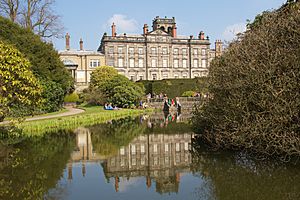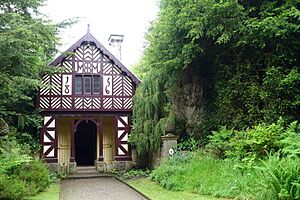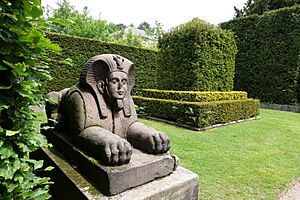Biddulph Grange facts for kids
Quick facts for kids Biddulph Grange |
|
|---|---|
 |
|
| Type | Landscaped Victorian garden |
| Location | Grange Road, Biddulph, Staffordshire, England |
| Area | 15 acres (6.1 ha) |
| Founder | James Bateman |
| Operated by | National Trust |
Biddulph Grange is a fantastic garden looked after by the National Trust. It's located in Biddulph, near Stoke-on-Trent in Staffordshire, England. This garden is not the same as Biddulph Grange Country Park. It's a special place with lots of hidden surprises and different themed areas.
Contents
Discover Biddulph Grange Gardens
Imagine stepping into a garden that feels like a trip around the world! Biddulph Grange has amazing hidden areas. It's like finding whole new continents, including China and Ancient Egypt. You can also explore Italian terraces and a Scottish glen.
The garden is beautiful all year round. In late spring, the rhododendrons and azaleas burst with color. The pinetum, which is a collection of pine trees, and the evergreen topiary (shaped bushes) are always interesting. It's a great place for kids, with fun tunnels and rocky paths to explore. There's even a quiz trail to make your visit an adventure!
The clever design of Biddulph Grange makes it special. The different garden areas are hidden from each other. They use big piles of rocks and thick bushes to keep them separate. This design fits together perfectly, like a jigsaw puzzle. You'll find beautiful Italian-style terraces connected by steps. At the bottom, tall hedges create a lovely dahlia walk.
In the Egyptian part of the garden, two sphinx statues guard a dark tunnel. This tunnel invites you to explore. Deep inside, you'll find a spooky "bloody chamber." It's lit by a hidden red window. Inside, there's a half-spooky, half-funny statue of the Ape of Thoth.
Explore Themed Garden Areas
The garden is split into many different areas, each with its own cool theme. Here are some of them:
- Chinese garden
- Egyptian garden
- Western Terrace
- Italian Garden
- Lime Avenue
- Rhododendron Ground
- The Glen
- Pinetum and Arboretum
- Bowling green and Quoit Ground
- Cheshire Cottage
- Wellingtonia Avenue
- The Stumpery
- Dahlia Walk
- Lower, Rose, Verbena and Araucaria Parterres
- Cherry Orchard
The History of Biddulph Grange
Biddulph Grange was created by James Bateman (1811–1897). He was a very talented gardener and landowner. James inherited money from his father, who became rich from coal and steel businesses. Around 1840, James moved to Biddulph Grange.
He designed the gardens with help from his friend, Edward William Cooke. Edward was an artist who painted seascapes. The gardens were made to show off James Bateman's huge collection of plants from all over the world.
James and his wife Maria loved plants and had enough money to follow their passion. As their house grew bigger, they started working on the gardens around it. Edward William Cooke helped them. His father-in-law owned one of the biggest plant nurseries at the time. James Bateman collected plants brought back by famous Victorian plant-hunters. He became an expert on orchids.
James Bateman was also the president of the North Staffordshire Field Society. He helped the Royal Horticultural Society find new plants. He especially loved rhododendrons and azaleas. James had several famous sons who grew up at Biddulph Grange, including the painter Robert Bateman.
His gardens are special because they show a time between older landscape gardens and the very detailed Victorian style. The gardens are divided into separate themed areas, like Egypt and China.
In 1861, James Bateman and his sons had used up their money. They left the house and gardens, and James moved to London. Robert Heath bought Biddulph Grange in 1871. The house burned down in 1896, but architect Thomas Bower rebuilt it.
From 1923 until the 1960s, the rebuilt house was a children's hospital. It was first called the "North Staffordshire Cripples' Hospital." Later, it became the "Biddulph Grange Orthopaedic Hospital." During this time, the 15-acre garden became very run-down. The deep terraced area near the house, called Dahlia Walk, was even filled in. It was made into a big lawn for patients. The land was split up. The hospital got the house and its gardens. The rest of the land became the Biddulph Grange Country Park.
For almost a century, the gardens were neglected. They were mostly visited by vandals.
Bringing the Gardens Back to Life
In 1988, the National Trust took over the property and its gardens. They have worked hard to restore almost everything. This included a long project to dig out the Dahlia Walk area. They used methods like archaeologists to find forgotten parts of the garden. From 1995 to 1996, the Wellingtonia Walk was replanted. The old trees were cut down because they were too old and gappy.
As of March 2007, the last part being restored was the Woodland Terrace. A hospital building on this site was removed a few years ago. The famous Great Wall of China has also been rebuilt. This was done to fix problems from the ground sinking over time. This work was finished in the winter of 2010–11. A new path called the Woodland Walk was created in 2011. It winds through the woods next to the Wellingtonia Walk. In 2011, they also started planting flowers in Dahlia Walk. This was to make it colorful before the dahlias bloomed.
Images for kids
-
Biddulph Grange: the China area is modelled after the willow pattern plate
-
Biddulph Grange: the pinetum
-
Rhododendron arboreum at Biddulph Grange Gardens, 18 April 2009




















